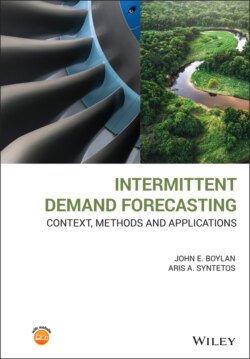Читать книгу Intermittent Demand Forecasting - John E. Boylan - Страница 29
1.4.4 Current and Future Applications
ОглавлениеRecent IT developments have greatly expanded the areas of application of intelligent intermittent demand forecasting methods. Data at a very low level of granularity have become available, which means that environments where traditionally intermittence would not be a problem now become natural candidates for further consideration. Take the retailing sector as an example: this is a traditionally fast demand environment where even the slower moving items sell in considerable volumes every day, making intermittent demand forecasting redundant. However, the current availability and utilisation of data for replenishment purposes, as often as three times per day, means that more items have intermittent demand. Although daily demand may not be intermittent, half‐daily demand could be, and demand over a third of a day most probably will be.
Another factor in retail, highlighted by Boylan (2018), is the broadening of product ranges in larger retail outlets, with grocery stores introducing more clothing lines, for example. These items will often be slower moving than staple food ranges, thereby increasing the proportion of intermittent items. Recent discussions with major supermarkets in the United Kingdom such as Sainsbury's and Tesco indicate that intermittent demand forecasting has become one of their major problems.
Intermittent series occur in many other settings. For example, the planning of inventories for emergency relief must address highly intermittent and lumpy demand. Indeed, the benefits of good forecasting and planning (for any type of series) apply just as much to charitable and not‐for‐profit organisations as they do for profit‐making wholesalers and retailers. Support for the promotion and realisation of these wider benefits is being offered at the time of writing by the ‘Forecasting for Social Good’ (www.f4sg.org) and ‘Democratising Forecasting’ initiatives launched in 2018 by Dr Bahman Rostami‐Tabar.
Nikolopoulos (2021) made a strong case for the use of intermittent forecasting methods for series that are not intermittent but have sporadic peaks. These time series can be decomposed into two subseries: a baseline series and one containing more extreme values. Standard time series or causal methods can be used for the former. The latter include rare but expected events (‘grey swans’) and truly unexpected special events (‘black swans’) (Taleb 2007) and can be addressed using intermittent forecasting methods, at least as a benchmark against which other methods may be compared. Methods to address intermittence have their origins in inventory planning, but Nikolopoulos (2021) argued that these forecasting methods can be used more widely in business, finance, and economics or, indeed, in any other discipline. This line of enquiry will not be pursued in this book, although it seems a very promising direction for future research.
